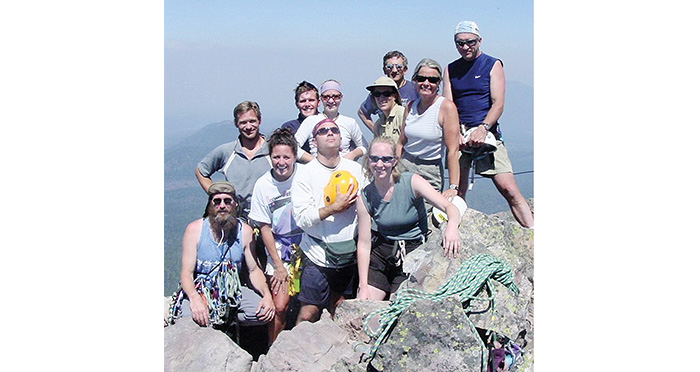(Photo above: Perched on the summit of Mt. Washington | courtesy of Rosell Wealth management)
Know The Risks When Climbing Your Financial Mountain
In August of 2003 a group of friends and I decided to climb Mount Washington. This shield volcano is among the most recognized mountains in Oregon’s Cascade Range as it rises above the burned-over forest like nature’s skyscraper. Ironically, the fire I am alluding to started the day we summited Mt. Washington. The B&B Complex Fires eventually burned more than 90,000 acres over a period of five weeks. We watched the fire consume Douglas fir and Ponderosa pine with a vengeance, having no idea that the blaze would last for 34 days.
At the peak of the firefighting effort, there were over 2,300 personnel working on the blaze. Days later, President George W Bush would fly over the devastation after a Portland fund-raising stop before heading down to play golf at Crosswater Resort in Sunriver with his college buddies. He was the first sitting president to visit Central Oregon. I remember thinking to myself, “Really, that’s what it takes to get a president to Central Oregon?”
But I’m getting ahead of myself.
We accessed Mount Washington’s slopes via the Pacific Crest Trail. Over the years, I’d been on sections of this 1,100-mile stretch before reading Wild, Cheryl Strayed’s journey of self-discovery. Fortunately, this trip would be a lot shorter than hers. Unfortunately, the rock on Mount Washington’s steep slopes has a reputation for being extremely poor, reminiscent of a crumbling rock pile. Some feel it is not stable enough to climb, however if you know what you’re doing and are careful while doing it there should be no problems.
Unlike most of the other nearby mountains—where you can hike and scramble to the summit in the summer months—all routes up Mount Washington are rated Class 5 or higher. Translation? Even though most climbers can easily reach the top without the aid of ropes, a fall can be fatal. So we wisely opted for the protection of a rope to safely climb to the summit.
The hiking grew steeper, and the views more spectacular, as we ascended. Hot and sweaty, we eventually reached the Summit Block at 7,300 feet. The hike was over and the climb was beginning. Out came our helmets and harnesses. It was time to rope up. The first pitch is the chimney, a 60-foot wall of sharp and friable basalt. John and Matt climbed ahead and set the rope, allowing Mark and me to follow. All eyes on the lookout for falling rock.
We reached the second pitch just below the summit where I viewed Mount Jefferson and Three Fingered Jack piercing through the thickening layer of smoke. The exposure was extreme to say the least. I originally started rock climbing to overcome my fear of heights and this portion of the climb was not for the faint of heart. As we worked our way to the summit I kept telling myself to just look at the rock in front of me and not down below. I knew vertigo is all mental, and that I just needed to relax. So I embraced the fact that after 50 feet it doesn’t matter how high you are. If you fall, you’re dead either way.
Before I knew it our group of eleven was perched on the summit of Mount Washington, which could be a table top in heaven high above the world and on this day the mounting smoke below. For me, arriving to the summit of any awe-inspiring peak is a spiritual moment. Once I’ve been to the top, I never seem to look at it the same way.
It was now time for the second half of the journey. We prepared the leave the Summit Block behind and headed to our rope. Rappelling down such a mountain begins with a test of trusting your best friend—you! Leaning back, you step off the edge with rope in hand, feeding it through your ATC, and begin the descent. The exposure below got my full attention. To put it another way: gulp.
For me and my climbing partners it’s essential to have the right attitude and an adventurous spirit. You must trust your partner, as well as inspecting and having confidence in your gear. But most importantly it’s about not making foolish decisions. We all had the skill set to free climb the Summit Block without ropes however one slip, game over, and we’d be gone. It’s okay to take risks but not brainless ones.
In Failure Is Not an Option I share the eight fundamental risks every retiree faces and help you create more certainty in the uncertainty of retirement with the intention of helping people achieve far greater financial peace of mind, since—just like climbing a mountain—those who recognize and address these risks are most likely to safely and successfully complete their journey.
One of these risks is inflation. Simply put, inflation means that every year your money buys a little—or a lot—less than it did the year before. The average U.S. inflation rate of 3.5 percent may not sound like much, especially when we compare it to countries like Venezuela—currently experiencing a 481% inflation rate¹. But even at a 3.5% rate of inflation means that prices will double every 20 years. How does this impact your retirement?
Inflation erodes your purchasing power. Let’s take a look at inflation’s detrimental effects during a 30-plus year retirement. In 1980 the average new car cost $7,574. Today that same car costs over $30,000. In 1980 the average new home cost $62,900. Today the average cost of a new home is over $300,000.
Imagine retiring at age 60 with an annual income of $100,000. Twenty years later at the age of 80, you will need to withdraw $200,000 from your same retirement accounts just to maintain that same standard of living. This doesn’t even factor in additional costs of health care and possible long-term care expenses. If you happen to live to age 100, this figure will have doubled once again and you will need $400,000 each year to purchase what $100,000 purchases today. When clients find this hard to fathom, I share with them that they probably spent more money on their last automobile than their parents spent purchasing their first home. This is when they begin to see the daunting effects of inflation. Then I share with them that it is highly likely we are going to be entering an inflationary period as the Fed prints more bills and interest rates eventually rise, thereby triggering a related rise in the inflation rate. I don’t want to worry them, but they need to understand how down the line inflation can impact their bottom line by devaluing how much their money is actually worth.
It is important to understand the financial risks that you will face and plan today so that you and your family will live the life you have always imagined.
¹ www.Statistica.com
David Rosell is President of Rosell Wealth Management in Bend. www.RosellWealthManagement.com. He is the author of Failure is Not an Option- Creating Certainty in the Uncertainty of Retirement. Read about his book at www.DavidRosell.com or Amazon.com. Ask for David’s book at Barnes & Noble, Newport Market, Cafe Sintra, Bluebird Coffee Shop, Dudley’s Bookshop and Sunriver Resort.
Investment advisory services offered through ValMark Advisers, Inc. an SEC Registered Investment Advisor
Securities offered through ValMark Securities, Inc. Member FINRA, SIPC 130 Springside Drive, Ste 300 Akron, Ohio 44333-2431. 800 765-5201. Rosell Wealth Management is a separate entity from ValMark Securities, Inc. and ValMark Advisers, Inc.





